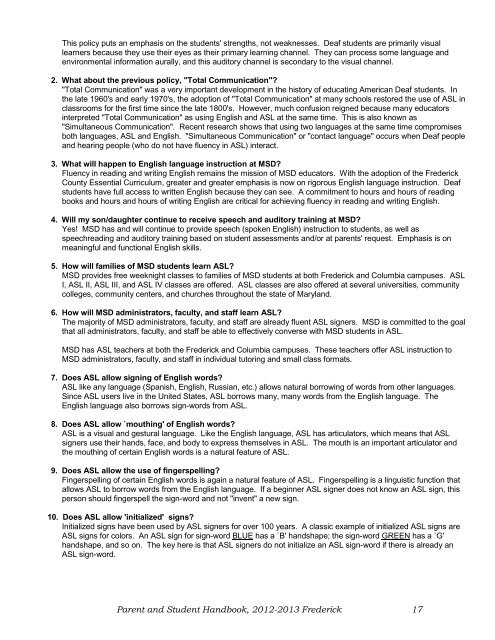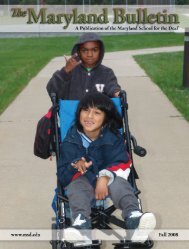Frederick Campus - Maryland School for the Deaf
Frederick Campus - Maryland School for the Deaf
Frederick Campus - Maryland School for the Deaf
You also want an ePaper? Increase the reach of your titles
YUMPU automatically turns print PDFs into web optimized ePapers that Google loves.
This policy puts an emphasis on <strong>the</strong> students' strengths, not weaknesses. <strong>Deaf</strong> students are primarily visual<br />
learners because <strong>the</strong>y use <strong>the</strong>ir eyes as <strong>the</strong>ir primary learning channel. They can process some language and<br />
environmental in<strong>for</strong>mation aurally, and this auditory channel is secondary to <strong>the</strong> visual channel.<br />
2. What about <strong>the</strong> previous policy, "Total Communication"?<br />
"Total Communication" was a very important development in <strong>the</strong> history of educating American <strong>Deaf</strong> students. In<br />
<strong>the</strong> late 1960's and early 1970's, <strong>the</strong> adoption of "Total Communication" at many schools restored <strong>the</strong> use of ASL in<br />
classrooms <strong>for</strong> <strong>the</strong> first time since <strong>the</strong> late 1800's. However, much confusion reigned because many educators<br />
interpreted "Total Communication" as using English and ASL at <strong>the</strong> same time. This is also known as<br />
"Simultaneous Communication". Recent research shows that using two languages at <strong>the</strong> same time compromises<br />
both languages, ASL and English. "Simultaneous Communication" or "contact language" occurs when <strong>Deaf</strong> people<br />
and hearing people (who do not have fluency in ASL) interact.<br />
3. What will happen to English language instruction at MSD?<br />
Fluency in reading and writing English remains <strong>the</strong> mission of MSD educators. With <strong>the</strong> adoption of <strong>the</strong> <strong>Frederick</strong><br />
County Essential Curriculum, greater and greater emphasis is now on rigorous English language instruction. <strong>Deaf</strong><br />
students have full access to written English because <strong>the</strong>y can see. A commitment to hours and hours of reading<br />
books and hours and hours of writing English are critical <strong>for</strong> achieving fluency in reading and writing English.<br />
4. Will my son/daughter continue to receive speech and auditory training at MSD?<br />
Yes! MSD has and will continue to provide speech (spoken English) instruction to students, as well as<br />
speechreading and auditory training based on student assessments and/or at parents' request. Emphasis is on<br />
meaningful and functional English skills.<br />
5. How will families of MSD students learn ASL?<br />
MSD provides free weeknight classes to families of MSD students at both <strong>Frederick</strong> and Columbia campuses. ASL<br />
I, ASL II, ASL III, and ASL IV classes are offered. ASL classes are also offered at several universities, community<br />
colleges, community centers, and churches throughout <strong>the</strong> state of <strong>Maryland</strong>.<br />
6. How will MSD administrators, faculty, and staff learn ASL?<br />
The majority of MSD administrators, faculty, and staff are already fluent ASL signers. MSD is committed to <strong>the</strong> goal<br />
that all administrators, faculty, and staff be able to effectively converse with MSD students in ASL.<br />
MSD has ASL teachers at both <strong>the</strong> <strong>Frederick</strong> and Columbia campuses. These teachers offer ASL instruction to<br />
MSD administrators, faculty, and staff in individual tutoring and small class <strong>for</strong>mats.<br />
7. Does ASL allow signing of English words?<br />
ASL like any language (Spanish, English, Russian, etc.) allows natural borrowing of words from o<strong>the</strong>r languages.<br />
Since ASL users live in <strong>the</strong> United States, ASL borrows many, many words from <strong>the</strong> English language. The<br />
English language also borrows sign-words from ASL.<br />
8. Does ASL allow `mouthing' of English words?<br />
ASL is a visual and gestural language. Like <strong>the</strong> English language, ASL has articulators, which means that ASL<br />
signers use <strong>the</strong>ir hands, face, and body to express <strong>the</strong>mselves in ASL. The mouth is an important articulator and<br />
<strong>the</strong> mouthing of certain English words is a natural feature of ASL.<br />
9. Does ASL allow <strong>the</strong> use of fingerspelling?<br />
Fingerspelling of certain English words is again a natural feature of ASL. Fingerspelling is a linguistic function that<br />
allows ASL to borrow words from <strong>the</strong> English language. If a beginner ASL signer does not know an ASL sign, this<br />
person should fingerspell <strong>the</strong> sign-word and not "invent" a new sign.<br />
10. Does ASL allow 'initialized' signs?<br />
Initialized signs have been used by ASL signers <strong>for</strong> over 100 years. A classic example of initialized ASL signs are<br />
ASL signs <strong>for</strong> colors. An ASL sign <strong>for</strong> sign-word BLUE has a `B' handshape; <strong>the</strong> sign-word GREEN has a `G'<br />
handshape, and so on. The key here is that ASL signers do not initialize an ASL sign-word if <strong>the</strong>re is already an<br />
ASL sign-word.<br />
Parent and Student Handbook, 2012-2013 <strong>Frederick</strong> 17






